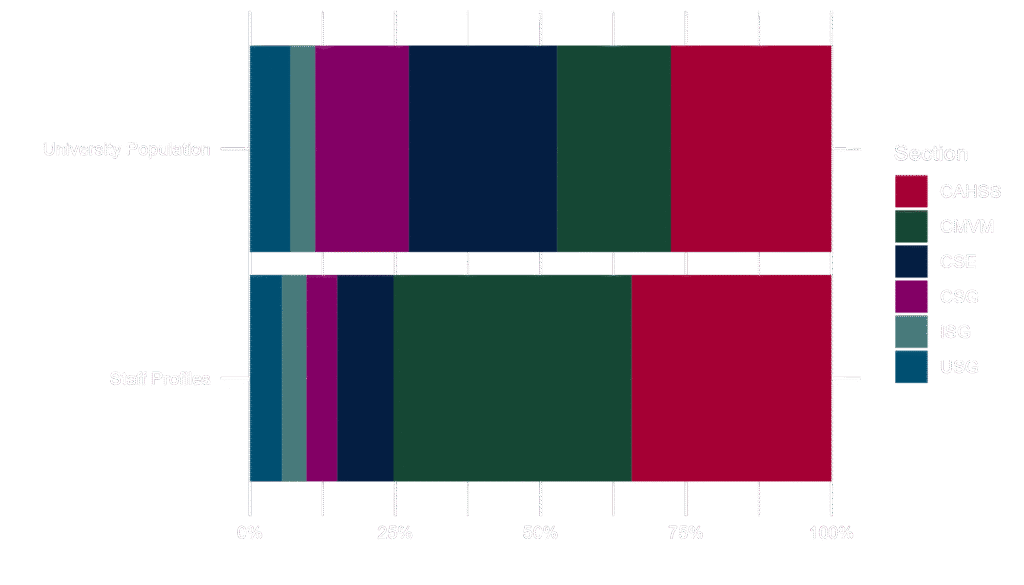Background
The University of Edinburgh offer staff the opportunity to create an online profile, with information about themselves and their career. The Role of Profiles research project was run by the User Experience (UX) team, in order to establish what staff want and need from these profiles. This involved surveys, interviews and desk research to gather opinions and data before presenting recommendations to improve the University’s profile offering.
One part of this project was discovery research to understand who currently uses staff profiles at the University, in the form of a detailed anonymous demographic analysis.
Methods
EdWeb profile data showed approximately 7840 Unique User Numbers (UUNs) recorded as having staff profiles. Of these, 2380 were PhD students, and the other 5460 University staff. HR Systems and Student Analytics and Reporting matched these UUNs with the data held in staff records and returned scrambled, anonymised datasets with the data disaggregated following the characteristics below:
- College/Section
- School/Unit
- Job Role
- Contract Type
- Working Pattern
- Grade
- Gender
- Age
- Ethnicity
- Nationality
- Disability
The latest EDMARC reports, Governance and Strategic Planning (GaSP) EDI Dashboards, and HR Staff Population Statistics from 2023-24 were used for comparing with overall University figures, to allow evaluation of over or underrepresentation of certain demographics. One proportion Z-tests were used to test for statistical significance.
Approximately 19% of the UUNs were not able to be matched with demographic data. This was due to the UUNs not matching active staff records, indicating the staff member no longer worked for the University. These were hence excluded from the dataset, although became an important point of discussion in the project, with the absence of data often revealing an issue in itself.
Key Findings
College/Section
The largest proportion of usage amongst staff came from the College of Medicine and Veterinary Medicine (CMVM), with 41% of profiles being from CMVM. The College of Arts, Humanities and Social Sciences (CAHSS) comprised 34.4% of profiles, and staff from the College of Science and Engineering (CSE) made up 9.7%. Usage of staff profiles amongst the Professional Services Groups comprised of 5.5% being from the University Secretary’s Group (USG), 5.3% from the Corporate Services Group (CSG), and 4.2% from Information Services (ISG).
Figure 1 shows these proportions in comparison with the overall University population. The proportion of staff with profiles from ISG was very similar to the proportion in the overall population. However, colleagues from CAHSS and CMVM are overrepresented in the usage of profiles, and there were significantly less colleagues from CSE, CSG, and USG than would be expected from population figures.

Job Role
Almost half (48.3%) of all staff profiles were academics, with 37% being professional services, 7.6% technical, 3.4% clinical and 3.6% veterinary clinical. This compared to University population figures of 46.5% academic, 45.3% professional services, 5.4% technical, 1.8% clinical, and 1% veterinary clinical.
Regarding statistical significance, all job roles were overrepresented in staff profile usage except professional services, which was underrepresented when compared to University figures.
Contract Type
The majority of staff with profiles were on open-ended contracts at around 82.4%. Approximately 16.8% were on fixed-term contracts, and 0.8% on secondments. University-wide, open-ended staff comprised 65.5% of the population in 2023/24 and fixed-term 33.6%, resulting in fixed-term staff being underrepresented in staff profile usage.
Grade
Table 1 outlines the grade distribution across staff profiles and the population as a whole, and shows that staff on higher grades (UE07-UE10) were overrepresented in the use of profiles, with staff on lower grades generally underrepresented.

This demonstrates that staff on lower grades utilised staff profiles less than could be expected from the population, and may be a point of further exploration, with those on higher salaries more likely to use a potentially important tool for networking and recording professional success and expertise.
Impact
These figures were shared with the Role of Profiles project team and the research was then used to inform interviews, through targeting areas of underrepresentation to glean insight into the under-usage of profiles. This was part of the mixed-methods approach to understanding user behaviour of the staff profile service.
The UX Manager and lead of the project, Emma Horrell, posted a series of blog posts, including these findings and other desk research, survey and interview data. The blog series also reflects on the project and provides an overview of the recommendations created following the research.


